Posted inTechnology
Quantum Computing
Quantum Computing Quantum computing is an emerging field that leverages the principles of quantum mechanics to perform computations far more efficiently than classical computers for certain problems. Unlike classical bits…










